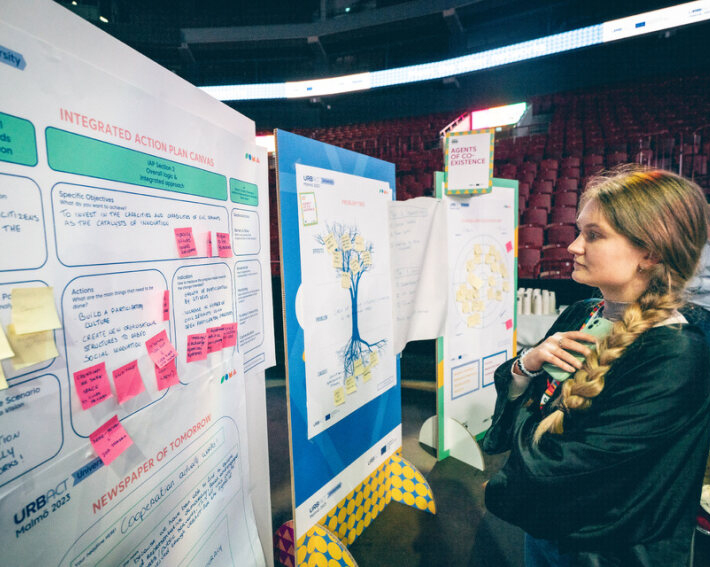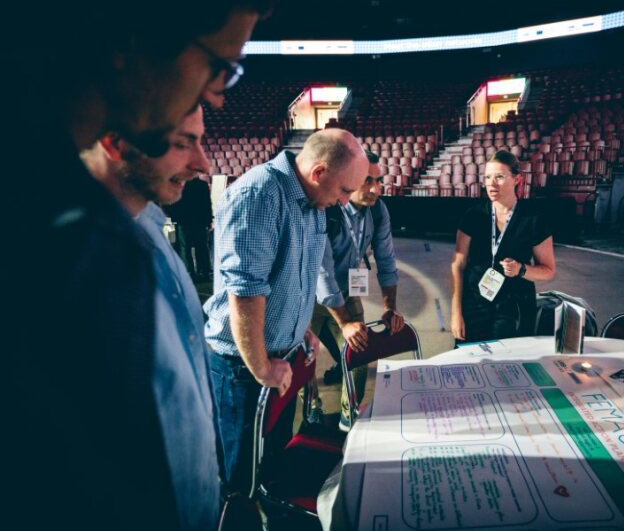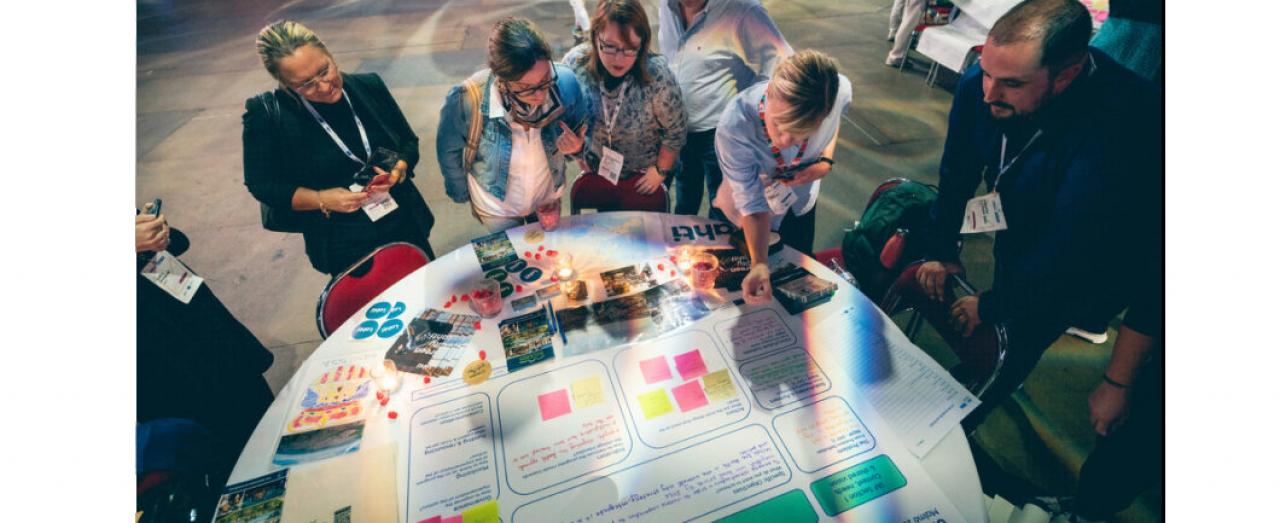A vital aspect to any action-planning journey is the development of coherent and well described actions that are framed by the policy challenge facing the city. As a matter of fact, it’s the most time-consuming part of the process for any municipality that is willing to pilot actions and operationalise them in the long run. This is no exception for URBACT cities. As the Integrated Action Plans study, which was conducted in 2022, points out municipalities can only benefit from a document that sets out coherently why, when, how and by whom a policy challenge associated with urban development can be addressed.
The recording of actions is the straightforward bit
 Particularly for the new round of Action Planning Networks, whose cities’ core focus is to co-develop Integrated Action Plans with their respective URBACT Local Groups, the stage of developing actions is the one that stakeholders will spend most time upon, will have the most fun with, will engage with most people on, and will face the greatest scrutiny upon from their transnational and local peers. But, what do good actions look like, how are they developed, and how can they be recorded?
Particularly for the new round of Action Planning Networks, whose cities’ core focus is to co-develop Integrated Action Plans with their respective URBACT Local Groups, the stage of developing actions is the one that stakeholders will spend most time upon, will have the most fun with, will engage with most people on, and will face the greatest scrutiny upon from their transnational and local peers. But, what do good actions look like, how are they developed, and how can they be recorded?
Leveraging on the URBACT tools
 As a part of the Toolbox, the programme seized the occasion of the URBACT University 2023, which took place in Malmö (SE) from 28-30 August, to launch a new tool. The Action Planning Canvas enables any city to record progress of their action planning-journey, while highlighting details and key information. Composed by four inter-linked sections, the Action Planning Network's cities experimented this tool to gather content for their Integrated Action Plans on the last day of the event.
As a part of the Toolbox, the programme seized the occasion of the URBACT University 2023, which took place in Malmö (SE) from 28-30 August, to launch a new tool. The Action Planning Canvas enables any city to record progress of their action planning-journey, while highlighting details and key information. Composed by four inter-linked sections, the Action Planning Network's cities experimented this tool to gather content for their Integrated Action Plans on the last day of the event.
The first section sets out the local context, needs and shared vision, all things that have been explored by the participants of the University during the first day of the event. The second section sets out the overarching logic framework, as well its link to an integrated approach. The las two remaining sections, aim at setting out further detail of specific activities and an implementation framework for any integrated action plan.
What do good actions look like?
Whilst the Action Planning Canvas is a key tool in recording the findings of the action-planning cycle, it can also be used as a mechanism to inform the creation of actions. There are five key factors that cities should consider when creating actions and to make them logical, coherent and good.
For starters, the actions should be framed by a clear and concise presentation of the problem and context. This could be a presentation in the Canvas, using the Problem Tree tool as a reference or it could be another visual representation of the context and focus of the project, such as this example from Razlog (BG) from the IoTXchange network. In the example below, it clearly details how the key considerations or problems facing Razlog around technological change have informed the focus areas for the city's Integrated Action Plan.

Second, the actions should be framed by a clear and coherent intervention logic. Below, the problems identified previously should flow into a clear overarching vision and a set of SMART (Specific, Measurable, Achievable, Realistic, Timebound) strategic objectives. These set out clearly what the city is looking to achieve. Again, using the example of Razlog, there is a clear link between vision, focus areas and strategic objectives:

Then, the actions should be reflective of URBACT’s integrated approach. Cities should be asking themselves (amongst other things) whether the actions will address economic, social and environmental challenges; whether they are reflective of URBACT’s three cross-cutting themes of gender, digital, and green; and whether they apply at all spatial levels of neighbourhood, municipality, region. Fundão (PT) from the SIBdev network have a really interesting way of demonstrating visually their integrated approach and link their overarching objectives to stakeholders to key sectors, and then to their actions:

Following these steps, the actions themselves should be presented in a clear, succinct and structured way. From previous experience, URBACT cities will generally detail three types of actions: there will be practical and project-actions, such as the hosting of events or the installation of new street signs; there will be process-actions, such as developing the capacity of social enterprises to bid for procurement opportunities or developing new technological systems; and there will be cultural change-led actions, as the development of Citizen Panels.
 La Rochelle (FR) from the Genderedlandscape network provides a good example of an Integrated Action Plan, which presents each action on one page, using the principles of the Canvas as the basis. The action of hosting a Workplace Gender Balance Webinar is well described and is accompanied by information about the format of the webinar, who the webinar will be provided by, and the key stakeholders that the webinar will be targeted at. It also includes wider information around the action owner, the finances needed to deliver the action and risks to implementation, as the image to the left illustrates.
La Rochelle (FR) from the Genderedlandscape network provides a good example of an Integrated Action Plan, which presents each action on one page, using the principles of the Canvas as the basis. The action of hosting a Workplace Gender Balance Webinar is well described and is accompanied by information about the format of the webinar, who the webinar will be provided by, and the key stakeholders that the webinar will be targeted at. It also includes wider information around the action owner, the finances needed to deliver the action and risks to implementation, as the image to the left illustrates.
Similarly, the city of Fundão presents a clear description of an action focused upon developing a transport on demand system that seeks to link the elderly population to wider services in the city. This is accompanied by expected results, potential resources and responsible organisations and wider stakeholders.
At last, each action should be accompanied by an indicator that enables a city to measure progress in the future. Indicators can either be quantitative – a number or percentage, or qualitative and change in perception or process. At the URBACT University, the GenProcure network used the Action Planning Canvas to create a specific action around supporting female-owned enterprises to access training to access procurement opportunities, with an accompanying indicator of % increase in female-owned enterprise delivering procurement contracts.
Developing actions
There are a number of tools that a city can use to develop their local actions in an integrated way, these can include:
- OPERA is a technique used for brainstorming within a multi-stakeholder group, like the URBACT Local Group, where members think of their own ideas, then discuss in pairs, then explain their ideas to the wider group, before ranking the most important, and finally arranging in order of potential delivery.
- Exploration and inspiring walks is a technique used to create new and inspirational ideas – most often undertaken on physical projects, it can be an informal way of recognising something that has not been thought of before.
- Lego and Playmobil can be used as a way of modelling out what neighbourhoods could look like in the future and a way of including stakeholders of all ages in action planning.
- Forecasting is a technique used to look into the future and think in a both quantitative and qualitative way of what the problem may look like in 10 or 20 years time, for example.
- Implementation Labs are often used once objectives and actions have been created and a way of exploring who should be involved in delivering them, funding them, and monitoring them.

Final thoughts
The Action Planning Canvas is a really helpful and straightforward to use tool, for the Action Planning Network's cities but also beyond. It will can help cities and networks to start to think logically about local Integrated Action Plans, to present succinctly the outcomes of exercises undertaken to identify problems and stakeholders, and to link together the different stages of the action-planning cycle. As cities start to develop their actions, it will also be helpful in identifying and prioritising specific actions for testing, and in then developing implementation plans.


